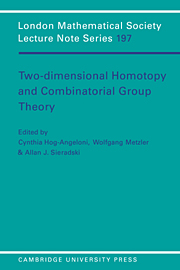Book contents
- Frontmatter
- Contents
- Editors' Preface
- Addresses of Authors
- I Geometric Aspects of Two-Dimensional Complexes
- II Algebraic Topology for Two Dimensional Complexes
- III Homotopy and Homology Classification of 2-Complexes
- IV Crossed Modules and Π2 Homotopy Modules
- V Calculating Generators of Π2
- VI Applications of Diagrams to Decision Problems
- VII Fox Ideals, N-Torsion and Applications to Groups and 3-Manifolds
- VIII (Singular) 3-Manifolds
- IX Cancellation Results for 2-Complexes and 4-Manifolds and Some Applications
- X J. H. C. Whitehead's Asphericity Question
- XI Zeeman's Collapsing Conjecture
- XII The Andrews-Curtis Conjecture and its Generalizations
- Bibliography
- Index
VIII - (Singular) 3-Manifolds
Published online by Cambridge University Press: 20 January 2010
- Frontmatter
- Contents
- Editors' Preface
- Addresses of Authors
- I Geometric Aspects of Two-Dimensional Complexes
- II Algebraic Topology for Two Dimensional Complexes
- III Homotopy and Homology Classification of 2-Complexes
- IV Crossed Modules and Π2 Homotopy Modules
- V Calculating Generators of Π2
- VI Applications of Diagrams to Decision Problems
- VII Fox Ideals, N-Torsion and Applications to Groups and 3-Manifolds
- VIII (Singular) 3-Manifolds
- IX Cancellation Results for 2-Complexes and 4-Manifolds and Some Applications
- X J. H. C. Whitehead's Asphericity Question
- XI Zeeman's Collapsing Conjecture
- XII The Andrews-Curtis Conjecture and its Generalizations
- Bibliography
- Index
Summary
While 2–complexes warrant study for their own complexities, the unresolved conjectures for 2–complexes described in Chapters X–XII arose from considerations of 2–dimensional spines of manifolds. This chapter investigates 2–complexes that are spines of closed orientable 3–manifolds and special 2–polyhedra that are spines of singular 3–manifolds.
3–Manifolds
This first section presents connections between combinatorial group theory and closed orientable 3–manifolds. A homotopy classification of these manifolds and an investigation of their spines are presented from the viewpoint of combinatorial squashings for them.
Representing 3–manifolds
By a 3–manifold, we mean a connected (second countable Hausdorff) space in which each point has a 3–ball neighborhood. This view of 3–manifolds as collections of overlapping 3–balls is too unstructured to contribute to their classification. To better understand 3–manifolds, especially closed orientable ones, numerous methods of representing them have been developed.
One can represent 3–manifolds as assemblages of basic bounded 3–manifolds that are glued along their boundary components in regulated manners.
Triangulations The simplest assemblage system is a triangulation, that is, a finite collection of tetrahedra whose 2–faces are identified in pairs via simplicial isomorphisms. The triangulability of closed 3–manifolds was established by E. Moise [Mo51]. This inherent structure of closed 3–manifolds contributes indirectly to their classification by offering a starting point for most other representations of 3–manifolds.
- Type
- Chapter
- Information
- Two-Dimensional Homotopy and Combinatorial Group Theory , pp. 251 - 280Publisher: Cambridge University PressPrint publication year: 1993
- 2
- Cited by



